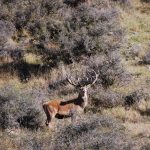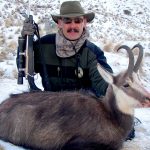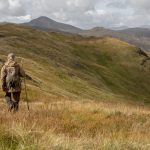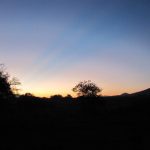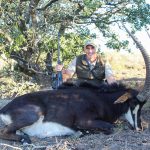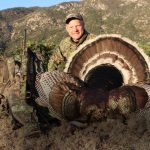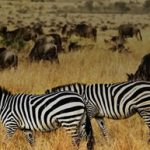Hunting free-range red and fallow deer on New Zealand’s scenic South Island.
The bugle of an elk sends chills up a hunter’s spine because of its wild, wonderful sound so emblematic of the wilderness. The roar of a red stag does the same thing for the same reasons. But the first time you hear a stag roar, you might think you are being stalked by a predator. The sound is deep and guttural, containing a note of challenge that leaves no doubt in the listener’s mind that the animal behind it is ready to take on all comers.
On this April morning, the stag crashing in the thick brush somewhere in front of me was roaring almost continuously, and my guide, Will Patterson, was roaring back. I was kneeling behind my rifle, which I had rested on a set of shooting sticks, frantically dialing the scope from 9X to 3X because there was no doubt we were about to have a red stag right on top of us.
I had caught a glimpse of the stag a moment ago about sixty yards away, storming toward us, before the brush swallowed him again. There was no chance of a shot. Now the stag was directly behind a bush and I adjusted my position slightly and tried to calm the jackhammering in my chest. Will gave one more roar of challenge. All at once an enormous, copper-coated deer loomed in my scope, coming up over a little rise, head-on at less than forty yards. I tore my eyes from the magnificent, towering antlers and focused on the red hide rapidly filling the scope lens. Holding the cross hairs on the spot where the neck joined the chest, I pressed the trigger of my 7mm magnum.
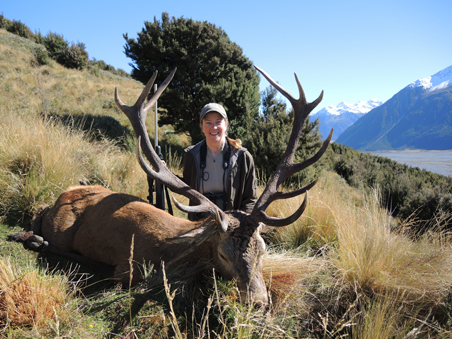
A beautiful free-range “royal” red stag taken on the South Island.
I had heard the roar of a red stag for the first time just the night before, shortly after arriving at beautiful Manuka Point Lodge in the Methven-Canterbury region of New Zealand’s South Island. The lodge, owned by Don and Julie Patterson, is situated at the confluence of the Rakaia and Mathias Rivers–broad, braided streams fed by snowmelt and flanked on both sides with steep mountains and snowcapped peaks. On the point of land between the two rivers is a 2,000-acre high-fenced hunting estate, home to red stags and fallow bucks of eye-popping proportions. The rest of the area—some 23,000 acres of steep, rugged ridges along both rivers–is wild land, magnificent country covered with tall trees, grassy openings, and brushy stands of a shrubby native evergreen called manuka.
This was the area I was hunting in, and as I was soon to find out, it is the stomping grounds of one of the oldest free-range red stag herds in New Zealand. Will and I had taken a hike up the valley the night before, and as dusk fell, roars arose eerily from the dark timber around us. I was thrilled—it seemed I had timed my hunt perfectly for the stags’ rutting period, which peaks in early April.
The history of red stags in New Zealand is controversial. The country’s first European settlers, dismayed by the fact that their new home had lovely wild country but no native big game, formed “Acclimatisation Societies” in the late 1800s with the goal of making New Zealand more like Britain, especially when it came to hunting. They imported and released a plethora of game animals including red stags and fallow deer–as well as other animals of more dubious value such as Australian opossums–all of which thrived in the excellent habitat and friendly climate. Later generations came to have some regrets over these efforts once they realized the importance of preserving native vegetation and habitat, but the game genie proved nearly impossible to put back in the bottle.
An important chapter in this story started right here at Manuka Point, where some of the first and finest red deer in New Zealand were released by the North Canterbury Acclimatisation Society in 1897. In his 1970 book The Red Stags of the Rakaia, author D. Bruce Banwell writes:
“The Rakaia red deer herd … is, without doubt, the greatest herd of red deer in New Zealand …. These were the animals descended from the deer imported from England by the North Canterbury Acclimatisation Society in 1897 and purchased from the then-famed pastoral parks of Stoke Park in Buckinghamshire.
“The ancestors of these great stags from Stoke can be traced back to the wild indigenous red deer of Britain, of which the Highland red deer of Scotland is the only surviving remnant in any numbers. To these animals had been introduced red deer from several parts of Germany, and from this interbreeding developed a type of red deer that, when released in the mountains of the South Island of New Zealand, produced antlers far beyond the expectations of those who were responsible for their purchase.”
The descendants of these deer, brought halfway around the world more than 120 years ago, still populate the steep mountainsides of the Pattersons’ free-range hunting area. As a young man, Don Patterson used to come to the Rakaia Valley with his buddies, camping and hunting, and was captivated by the beauty of the region. In those days, the Rakaia red deer herd was recovering from a period of helicopter culling by the New Zealand government. Over the years, however, the herds began to rebuild.
In 2002, Don realized a long-held dream when he was able to purchase the 25,000-acre property and start a hunting outfit. Now, like many responsible landowners and outfitters in New Zealand, Don works to maintain one of the country’s finest remaining free-range deer herds in balance with the habitat, maximizing hunting opportunities while managing the deer to minimize damage to the native plant communities.
Don’s Manuka Point Lodge is a 100 percent family-owned and -run operation. Don and his son Will do most of the guiding, ably assisted by a cousin, Dave Reese. Don’s wife, Julie, and Will’s wife, Marianne, manage the lodge and turn out magnificent meals, and Don’s other son Ben is a pilot, taking visitors on hunts in other areas and on scenic flights over the Southern Alps. Their beautiful lodge has huge windows opening on a staggering view up the Rakaia Valley; it’s a place where you sink onto a couch, stare at the view, and wish you lived there.
The comfort of the lodge is especially welcome because hunting the mountains above Manuka Point is not for the faint of heart. On the day we called in the stag, Will and I had set out from the lodge before dawn and hiked for several hours, scaling an increasingly vertical slope until I was certain I could not take another step. But the stags were roaring continuously around us, we had a breathtaking view of the braided river far below, and it seemed we could nearly touch the snowcapped peaks across the valley. The climb put us in an excellent position to slip in above the stags and hinds scattered through the manuka below us. As we glassed, we could hear frequent roars and I could see the tips of antler tines moving in the brush.
We moved slowly across the slope, keeping the wind in our favor, but as the morning wore on, the sounds of the stags ceased. Will decided to try to make something happen, and I was impressed with the realistic roar he was able to produce with his voice. Even more impressive was the instantaneous response. The stag’s challenge reverberated through the manuka below us.
We dropped our packs and crawled to where we could see better. The stag was crashing toward us though the brush. I set up the sticks, rested my rifle, cranked down the magnification on my scope, and tried desperately to maintain my composure as the roaring—from both my guide and the stag—grew louder.
When the stag finally came storming out of the manuka brush, my shot, at nearly point-blank range, struck him in the front of the chest and bowled him over backward, and he was kicking his last when Will and I hurried across the side hill to where he was. The adrenaline from the encounter was still coursing through me as I picked up the stag’s head to admire his magnificent antlers. They took my breath away; the twelve points–three lower tines on each antler and a “crown” of three additional points at the top–made him a classic “royal” stag, a prime example of a wild red deer.
The Fallow Buck
While taking the magnificent royal stag was plenty of excitement for one hunt, there was more to come. At one point on our long slog up the mountain that morning, Will and I had stopped to catch our breath and glass, and in doing so spotted a lovely cream-colored fallow buck far below. I had never seen a fallow deer before and was intrigued by its spotted coat and odd-shaped, palmated antlers. After I killed the stag, Will suggested we try for the fallow—an offer I certainly couldn’t refuse.
The next morning, as we approached the area where we’d spotted the buck the day before, we saw that he was still there, prancing restlessly near a small herd of does. We made what I thought was a great stalk through the manuka, but as we closed the distance to less than 200 yards, the buck vanished around the side of a small hill. We crept over the crest as quietly as we could, but couldn’t spot him anywhere.
We sat there for a while and glassed into grassy spots and patches of thick brush. We spotted several more red stags, including a nice 8-point, and were intrigued for some time by an especially deep-throated roaring in a manuka-choked swale above us. We glassed it hard, but never saw the stag that was making the racket, and our fallow buck never reappeared.
Undaunted, we were back at it in late afternoon, watching the fallow deer’s favorite spot, but he never showed. It turned out to be an incredible evening, though, with red stags roaring from the brushy hillsides and fallow bucks croaking like bullfrogs. These sounds of the rut surrounded us as we hiked out under an almost-full moon rising in a pink sky over the snowcapped mountains flanking the Mathias Valley.
We returned the following evening, but the wind was squirrelly, so we decided to circle and come in high above the fallow’s favorite spot. We climbed the steep slope and found a place to sit in a patch of mountain daisy where we had a good view of the little knob where we had first seen the deer. It was quiet for a long time, and then, about an hour before dark, the buck appeared out of the brush below us. He spent ten minutes or so furiously beating up a manuka bush with his antlers, but the cover around him was so thick I didn’t have a shot.
Finally he stepped clear and stood broadside at 200 yards. I was already set up on my shooting sticks and had the cross hairs focused on him, so I took a deep breath and squeezed the trigger gently. The deer took off like a rocket, running full-tilt straight up the knob so fast I could not get on him for a follow-up. He vanished over the crest.
We grabbed our gear and headed down the hill, crawling through a thick patch of manuka that turned out to be the buck’s core area—a den of muddy trails and scrapes beneath the canopy of brush that had hidden him so well. On the other side of it, we climbed the knob and as I cast back and forth on the other side, I quickly found him, piled up dead from my single shot. He had run a little more than 100 yards.
It was the largest free-range fallow buck ever killed at Manuka Point, and Will and I were thrilled that our patience in hunting him over several days had paid off. We carried the buck out under the light of a full moon shining over the mountain peaks. Around us, red stags roared and fallow bucks croaked, joining their voices in the spine-tingling chorus of an autumn night in New Zealand.
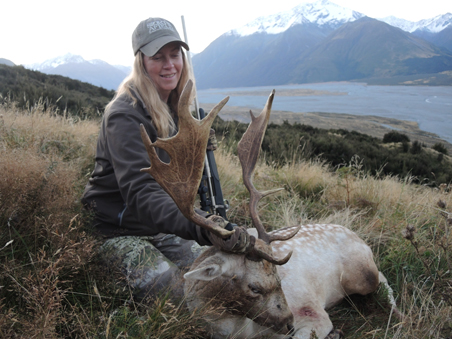
This fine fallow deer, which the hunters first spotted while stalking the red stag, was an unexpected bonus.
Gear For New Zealand
I took my old reliable Remington 700 in 7mm Remington Magnum on my New Zealand hunt. This time, though, I fed it something new: Hornady’s Precision Hunter ammo loaded with the brand-new 162-grain ELD-X bullet. To say this ammunition performed well would be an understatement. The shots at the two animals I took could not have been more different: a 40-yard shot into the chest of a heavy, amped-up red stag, and a 200-plus-yard broadside shot at a much smaller, thin-skinned fallow deer. The results on both were dramatic, with the stag literally bowled over backward and the fallow expiring with a single shot after a headlong rush. I became an immediate fan of the ELD-X.
I felt pretty eagle-eyed with Swarovski’s new EL Range binocular, which allowed me to easily spot stag antlers sticking out of the manuka brush and fallow deer moving through the trees—sometimes even before my sharp-eyed guide did. It’s easy to range game or nearby landmarks with the touch of a button as you’re glassing, with no need to carry a separate rangefinder.
Kuiu clothing is my go-to gear for any mountain hunt. It’s lightweight, which is great when you’re packing for an overseas hunt, and extremely versatile for a wide range of weather conditions. My Chinook jacket, Attack pants, Chugach NX rainwear, and Ultra Merino base layer all got lots of use and proved their worth many times over on my New Zealand trip.—D.R.
Hunting and Traveling in New Zealand
The family-owned and operated Manuka Point Lodge is truly a jewel of New Zealand hunting and is located in one of the most scenic spots I’ve seen on the South Island—which is saying a lot! Not only do the Pattersons offer both free-range and estate hunts for red stag and fallow deer on their magnificent property, they can also take you on a high alpine adventure for Himalayan tahr, chamois, Arapawa rams, and many other species. All Manuka Point hunts are scrupulously fair chase. For details, see www.manukapoint.com or e-mail [email protected].
New Zealand is one of my favorite countries in the world to visit. Not only does it have beautiful scenery, abundant game, and excellent hunting, its people go out of their way to be friendly and welcoming to tourists—hunters included. It’s easy to bring your own rifle; simply fill out the online application and your firearm permit will be waiting for you at the police office when you land in Auckland. (Manuka Point Lodge also has excellent rifles for rent should you prefer not to bring your own.)
My flight arrangements on Air New Zealand were made by Esplanade Travel, an established agency specializing in travel to the South Pacific and accustomed to working with hunters. Esplanade can also arrange additional tours, and you’re doing yourself a disservice if you don’t see some of the sights before or after your hunt. On this trip I spent a couple of days in Christchurch, rode the TranzAlpine train over the southern Alps to Greymouth, then flew up to the North Island and spent several enjoyable days hanging out with my relatives on the beautiful Coromandel Peninsula. I can’t wait to go back.—D.R.


